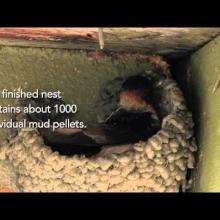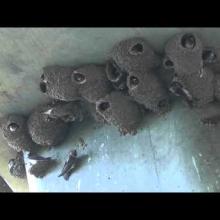

Join BirdNote tomorrow, November 30th!
Illustrator David Sibley and actor H. Jon Benjamin will face off in the bird illustration battle of the century during BirdNote's Year-end Celebration and Auction!
When Cliff Swallows arrive on the breeding grounds in North America, the dirty work begins. The swallows scoop up mud in their beaks and carefully build a gourd-shaped nest with a tapered opening. They add a lining of dry grass to keep eggs warm. It takes days of work and a thousand mouthfuls of mud to finish a single nest—and it’s just one part of a large colony.
Today’s show brought to you by the Bobolink Foundation.
BirdNote®
How Cliff Swallows Build a Nest
Written by Bob Sundstrom
This is BirdNote.
[Cliff Swallow calls]
Imagine you’re a Cliff Swallow, soaring and swooping on a long flight from South America in the spring. Sounds pretty nice!
But when you arrive in North America to nest, the dirty work begins.
[Music: “This Old House” theme]
To build a mud nest under the eaves of a barn, you and your mate have to find a mud puddle or creek. Next, start scooping up mud with your beak.
[Cliff Swallow calls]
You build the floor first: press a row of mud pellets against the wall 4-5 inches beneath an overhang, making a slight crescent shape. Once the floor extends far enough out, build the sides up.
To finish, give the roof a rounded taper, like the top of a jug. The opening, just wide enough to wiggle in and out, angles downward. Finally, line the inside with dry grass for the eggs. After days of work, and 1000 mouthfuls of mud, your nest is complete. And it’s just one part of a large colony.
[end music]
[Cliff Swallow calls]
Nesting on vertical human structures like bridges, culverts and buildings has helped the species expand its range. Even in new habitats, Cliff Swallow construction skills get the job done.
[Cliff Swallow calls]
For BirdNote, I’m Michael Stein.
[Music: “This Old House” theme]
###
Senior Producer: John Kessler
Content Director: Allison Wilson
Producer: Mark Bramhill
Managing Producer: Conor Gearin
Bird sounds provided by The Macaulay Library of Natural Sounds at the Cornell Lab of Ornithology, Ithaca, New York. Cliff Swallow Xeno Canto 172655 recorded by E. DeFonso, and Cliff Swallow Xeno Canto 580698 recorded by S. Hampton.
BirdNote’s theme was composed and played by Nancy Rumbel and John Kessler.
© 2022 BirdNote April 2022 Narrator: Michael Stein
ID# CLSW-03-2022-04-15 CLSW-03
Reference: https://birdsoftheworld.org/bow/species/cliswa/cur/introduction





